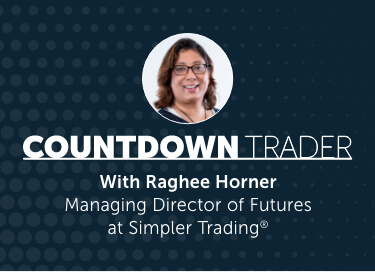What is macroeconomics and how does macroeconomics affect my trading?
Firstly, we need to define macroeconomics. A lot of folks think macroeconomics is some sort of mix of news and headlines. For our purposes, let’s just lose that as a definition.
Ask Google and you’ll find macroeconomics is the part of economics concerned with large scale or general economic factors such as interest rates and national productivity.
So what does that mean?
Well, interest rates take us to federal reserve monetary policy. It also can take us to the subsequent of money printing; our money supply. This is all influenced by that monetary policy. National productivity is going to go down to looking at something like the GDP (the gross domestic product). We’d then also be looking at inflation related to both interest rates and GDP.
Countdown Fun Fact: Inflation is one of the mandates of the Federal Reserve.
Part of macro economics is the Federal Reserve’s monetary policy, the money supply, interest rates, and the GDP. There are other types of economic measurements, but they’re typically going to fit into one of the categories we’re already talking about.
That’s how I look at macroeconomics…
You might say, well, what are they measuring? What’s the reason for these measurements? Well, macroeconomics really focuses on answering a few questions.
For example, that’s partially your GDP, right? What’s unemployment, in terms of the jobs picture? Which is why the Federal Reserve does look at jobs and also inflation.
What’s the national output? What’s the employment picture and what’s inflation? Remember the Federal Reserve has these leavers by way of interest rates.
The money printing and their policy to help control those things to levels that they feel are best for economic expansion, but not overheating. That’s going to bring us to our next question. What is it?
Overheated Economy
Isn’t a strong economy good? Yes, however, we want inflation of goods and services, but we need wage inflation as well. In other words, it’s fine if things cost more, but people need to make more as well.
These are the types of things we should be thinking about when looking at macroeconomics and how they affect our trading life because these policies affect employment. They affect the price and availability of goods and services, they affect international commerce, dollar strength, dollar weakness, etc. They affect the price of things that we pay for at the grocery store.
These are very real considerations to everyone, but even more so to us as traders and investors. That’s the bigger macroeconomics picture. Now we can talk about the different stages of this macroeconomic picture.
There’s something called the Goldilocks…yes, Goldilocks and the three bears. What’s the Goldilocks economy? It goes right back to that story – looking for something that’s “just right”. It’s a Goldilocks and three bears economy.
Nothing is too strong, nothing is too weak, It’s humming along just right. What does that mean? Decent inflation, but not sky high inflation, and employment is steady. GDP is going up steadily or stable as well. That’s what makes a stable economy that’s “just right.”
The Next Stage
The next stage we’re going to discuss then would be reflation. Reflation is simply a policy that’s designed to slow or stop deflation. Reflation is the increase of the value of goods and services, (hopefully, wages as well).
Deflation is of course just the opposite of inflation.
Here we’re talking about a reflation policy or a reflation stage. By the way, none of these stages simply magically happen. They’re the culmination of sometimes external forces like geopolitics and monetary policy creating certain environments.
However all these environments are created mostly by the Federal Reserve and monetary policy. None of these just happen out of the blue, this typically is a process that begins with monetary policy. One thing that isn’t talked about enough is the benefits from each stage.
In the Goldilocks economy, stocks and commodities do well. Commodity currencies like the Australian dollar Canadian dollar and New Zealand dollar also do well. By “well” I mean they’re bullish; they’re strong in a reflation. Reflation sometimes has a habit of accelerating very quickly or in a parabolic manner.
Along with reflation, you’ll typically see a weaker US dollar. You’ll also see another phenomenon, which is the phenomenon of short squeezes as the market scrambles to get long equities. Energies tend to do well in this environment, commodities, what I call grocery store commodities: grains, meats, and energies tend to do quite well.
What markets do well in inflation?
Typically Gold will do well and some commodities because we have rising inflation. A falling GDP and rising inflation is typically going to help your grocery store commodities: grains, softs, and your energies — even some of the metals. Inflation affects the commodities, but it’s not necessarily a great environment for equities because of the falling GDP and the higher cost of goods.
Falling GDP typically accompanies falling wage growth as well. What about deflation? Deflation has falling prices for goods/services and likely wages. What does well in deflation? Typically bonds, Gold, US dollar, Swiss, Frank, even Japanese yen. Those are more defensive type positions.
Notice we’re not talking about commodities and we’re not talking about equities.
Where are we now? Right now we’re in reflation. Focus for me is going to be tech industrials, basic materials, consumer discretionary momentum, or parabolic type moves. This includes those short squeezes, small caps, commodities, crude oil, copper, grains, and commodity dollars such as: Australian dollar, Canadian dollar, New Zealand dollar.
By the way, are those currencies from whose main economic support is the export of certain commodities? Yes, their economy is heavily reliant on exporting commodities to other countries, their production, or the mining of commodities and selling them to other countries.
Monetary policy is designed to combat deflation. It’s designed to help the output think GDP stimulates spending is a big part of that. That’s what you’ll typically see in reflation environments.
What’s the government trying to do? They’re trying to stimulate spending… How do you stimulate spending? Keep interest rates lower… that’s one very simple way. The Federal Reserve can stimulate spending and also lending — the two tend to go hand in hand.
Oftentimes, you’ll see reflation come on the heels of a recession. Sometimes it’s viewed as that first optimistic step in an economic recovery after a period of uncertainty. Moving on to the money supply and what the central bank will do — they will print more currency.
Again, this isn’t something that just happens and comes out of the blue. It’s part of why we see inflation in the reflation environment, more money, less value perceived for that money. Therefore goods and services will go up. Just some basic economics.



